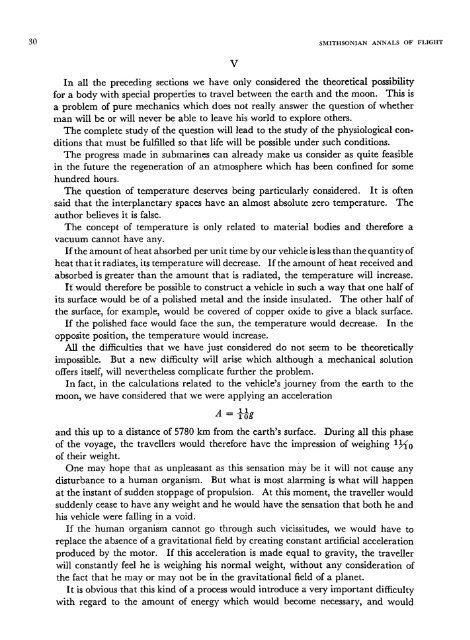FIRST STEPS TOWARD SPACE - Smithsonian Institution Libraries
FIRST STEPS TOWARD SPACE - Smithsonian Institution Libraries
FIRST STEPS TOWARD SPACE - Smithsonian Institution Libraries
Create successful ePaper yourself
Turn your PDF publications into a flip-book with our unique Google optimized e-Paper software.
30 SMITHSONIAN ANNALS OF FLIGHT<br />
In all the preceding sections we have only considered the theoretical possibility<br />
for a body with special properties to travel between the earth and the moon. This is<br />
a problem of pure mechanics which does not really answer the question of whether<br />
man will be or will never be able to leave his world to explore others.<br />
The complete study of the question will lead to the study of the physiological conditions<br />
that must be fulfilled so that life will be possible under such conditions.<br />
The progress made in submarines can already make us consider as quite feasible<br />
in the future the regeneration of an atmosphere which has been confined for some<br />
hundred hours.<br />
The question of temperature deserves being particularly considered. It is often<br />
said that the interplanetary spaces have an almost absolute zero temperature. The<br />
author believes it is false.<br />
The concept of temperature is only related to material bodies and therefore a<br />
vacuum cannot have any.<br />
If the amount of heat absorbed per unit time by our vehicle is less than the quantity of<br />
heat that it radiates, its temperature will decrease. If the amount of heat received and<br />
absorbed is greater than the amount that is radiated, the temperature will increase.<br />
It would therefore be possible to construct a vehicle in such a way that one half of<br />
its surface would be of a polished metal and the inside insulated. The other half of<br />
the surface, for example, would be covered of copper oxide to give a black surface.<br />
If the polished face would face the sun, the temperature would decrease. In the<br />
opposite position, the temperature would increase.<br />
All the difficulties that we have just considered do not seem to be theoretically<br />
impossible. But a new difficulty will arise which although a mechanical solution<br />
offers itself, will nevertheless complicate further the problem.<br />
In fact, in the calculations related to the vehicle's journey from the earth to the<br />
moon, we have considered that we were applying an acceleration<br />
A — io£<br />
and this up to a distance of 5780 km from the earth's surface. During all this phase<br />
of the voyage, the travellers would therefore have the impression of weighing ^}/{Q<br />
of their weight.<br />
One may hope that as unpleasant as this sensation may be it will not cause any<br />
disturbance to a human organism. But what is most alarming is what will happen<br />
at the instant of sudden stoppage of propulsion. At this moment, the traveller would<br />
suddenly cease to have any weight and he would have the sensation that both he and<br />
his vehicle were falling in a void.<br />
If the human organism cannot go through such vicissitudes, we would have to<br />
replace the absence of a gravitational field by creating constant artificial acceleration<br />
produced by the motor. If this acceleration is made equal to gravity, the traveller<br />
will constantly feel he is weighing his normal weight, without any consideration of<br />
the fact that he may or may not be in the gravitational field of a planet.<br />
It is obvious that this kind of a process would introduce a very important difficulty<br />
with regard to the amount of energy which would become necessary, and would

















